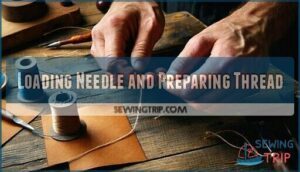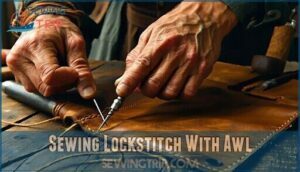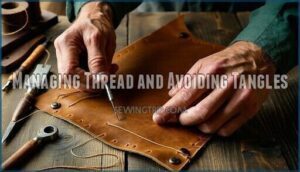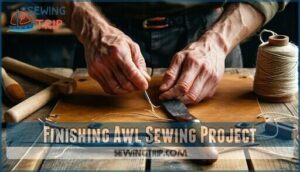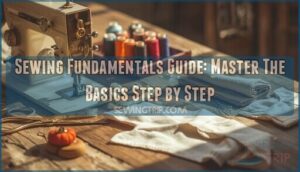This site is supported by our readers. We may earn a commission, at no cost to you, if you purchase through links.
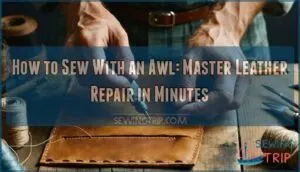 Learning how to sew with an awl transforms leather repair from intimidating to achievable.
Learning how to sew with an awl transforms leather repair from intimidating to achievable.
Start by threading your awl’s needle with waxed thread, leaving a long tail. Pierce through both leather pieces, pull the needle through, then push it back through the same hole from the opposite side.
This creates a lock stitch that won’t unravel. Keep tension consistent and work slowly – rushing leads to crooked stitches and torn leather.
The awl’s sharp point makes clean holes that grip thread securely, unlike regular needles that can tear thick materials. Once you nail the rhythm, even complex repairs become second nature because the awl allows for clean holes.
Table Of Contents
Key Takeaways
- Master the lock stitch technique – You’ll thread your awl’s needle with waxed thread, pierce through both leather pieces, then push back through the same hole from the opposite side to create an unraveling-proof connection.
- Choose the right awl for your project – You’ll need diamond awls for thick leather and heavy canvas, round awls for lighter materials, and curved awls for navigating tight corners or rounded surfaces.
- Prepare your materials properly – You’ll mark stitch lines clearly, clean the leather surface, and test your awl on scraps first to ensure proper thread weight and needle size combinations.
- Work slowly with consistent tension – You’ll maintain a steady rhythm and even pressure throughout stitching, keeping thread length manageable (arm’s length) to prevent tangles and ensure professional results.
Sewing Awl Basics
A sewing awl transforms tough leather repairs from impossible tasks into manageable fixes you can handle at home.
This handheld tool pierces thick materials and creates strong lockstitches that’ll outlast most machine-sewn seams.
A leather warrior that punches through impossibly thick materials with unstoppable precision.
Essential Tool for Leather Repair
A sewing awl transforms your leather crafting from frustrating to fantastic. This indispensable hand tool pierces thick materials while delivering heavy-duty thread, creating machine-strength lockstitches on saddles, bags, and camping gear.
Key benefits include:
- Repairs items where backside access is blocked
- Functions reliably in field or emergency situations
- Integrates needle storage with thread management
Your awl handles what regular needles can’t tackle. For efficient leatherwork, understanding leather awl tools is essential to achieve professional results, making it an indispensable tool for leather crafting.
Types of Sewing Awls Available
Different awl types tackle specific leather repair challenges.
Stitching awls feature threaded handles and lockstitch needles for heavy-duty repairs.
Diamond-shaped awls create precise slits for professional finishes.
Curved awls navigate tight corners effortlessly.
Scratch awls mark patterns and prepare holes.
The Speedy Stitcher Sewing Awl combines convenience with reliability for most projects.
When choosing an awl, consider the awl width requirements to guarantee the best results for your leather repair tasks.
Choosing The Right Awl for Project
Your awl selection determines project success. Match blade type to material thickness and stitch requirements. Diamond awls handle thick leather best, while round awls work for lighter materials.
Consider your skill level and comfort with different needle types.
- Diamond awls – Perfect for leather bags and heavy canvas with clean angled holes
- Round awls – Ideal for wallets and thin materials without over-piercing risk
- Curved awls – Essential for shoemaking and rounded surface projects
- Speedy Stitcher Sewing Awl – Complete awl sewing kit for immediate project starts
- Blade width matching – Align with pricking iron marks for consistent stitch spacing
How to Use Sewing Awl
Understanding your awl’s basic functions opens the door to mastering hand stitching techniques. The Speedy Stitcher Sewing Awl comes pre-loaded and ready for immediate use, making it perfect for quick repairs.
Here’s your step-by-step approach to awl sewing technique:
- Load the needle – Pull thread from the bobbin through the needle eye, leaving a working tail
- Pierce the material – Push the awl through both fabric layers at a consistent angle
- Create the lockstitch – Pull thread tight on both sides to form a secure connection
- Maintain steady rhythm – Keep your sewing speed consistent for even stitches.
Hand sewing awl projects require patience and practice. The awl sewing instructions emphasize proper thread selection – use heavy-duty thread for leather work. Awl history shows these tools have served craftsmen for centuries, proving their reliability.
Focus on awl maintenance between projects. Clean the needle regularly and check thread tension. This hand stitching method gives you complete control over stitch placement and strength. Mastering the awl stitching process is essential for achieving professional-looking results in leather repair.
Prep Your Materials
Before you start any awl sewing project, proper material preparation sets you up for success.
You’ll need to select the right thread weight and needle size for your specific fabric, then arrange your materials within easy reach for smooth stitching.
Selecting Right Thread and Needle
You’ll need the right combination to get professional results.
Match waxed polyester thread with appropriately sized sewing awl needles – typically 0.6mm thread works well with size 3 awl needles for most leather projects.
Your fabric choice determines stitch length and tension control requirements.
Test your awl sewing technique on scraps first using proper awl threader tool methods.
For superior results, understanding awl needle types is essential for selecting the correct tools.
Preparing Fabric for Awl Sewing
Before diving into awl sewing leather, proper preparation sets you up for success. Clean your leather surface and mark stitch lines clearly for consistent results.
- Mark your stitch line – Use a ruler and awl to score evenly spaced holes
- Clean the work surface – Remove dirt and oils that interfere with thread grip
- Test fabric thickness – Make certain your awl can penetrate without tearing the material
Fabric selection matters when sewing with awl techniques. Choose appropriate needle size based on your leather’s weight and desired stitch type.
Understanding the sewing awl basics is vital for mastering leather repair techniques.
Setting Up Awl for Immediate Use
Before you start stitching, proper awl preparation saves time and prevents frustration. Your sewing awl comes pre-loaded with thread, but checking these essentials confirms smooth operation.
| Component | Check | Action |
|---|---|---|
| Thread | Tension/Load | Verify bobbin is wound properly |
| Needle | Sharpness/Size | Select appropriate gauge for material |
| Handle | Grip/Stability | Confirm chuck lock is secure |
| Thread Path | Clear/Smooth | Remove any tangles or knots |
| Work Surface | Clean/Stable | Clear debris from stitching area |
This stitch setup prevents common threading issues that derail projects. Thread management starts with proper awl maintenance—a well-prepared tool makes clean, consistent stitches effortless, ensuring a successful stitching experience with smooth operation and clean stitches.
Sewing With Awl Techniques
Now you’ll master the core techniques that separate successful awl sewing from frustrating tangles and weak stitches.
These three essential skills will transform your leather repair projects from amateur attempts into professional-quality results.
Loading Needle and Preparing Thread
With your materials ready, you’ll thread the needle and prepare your working thread for leather awl sewing. Pull about 18 inches of waxed thread through the needle eye, leaving a 4-inch tail.
Check thread tension by gently tugging – it should move smoothly without binding.
- Thread the needle completely, ensuring the waxed thread slides freely through the eye
- Tie a simple overhand knot at the thread’s end to prevent pull-through during stitching
- Test thread tension by pulling gently – proper waxing prevents fraying and tangling
Sewing Lockstitch With Awl
Push your needle through the material from the back, drawing thread completely through with extra length.
Draw thread completely through, leaving extra length for proper lockstitch formation.
Pull the needle back slightly to create a loop, then pass the under-thread through this loop before pulling tight.
This lockstitch formation locks each stitch securely, providing exceptional awl stitch strength for leather awl technique and canvas awl stitching projects.
Managing Thread and Avoiding Tangles
Keep your thread length manageable—roughly arm’s length prevents tangling nightmares.
Maintain steady thread tension while pulling through leather; too loose creates sloppy stitches, too tight snaps the thread.
Store excess thread in your palm, feeding it gradually.
When knots appear, stop immediately and work them out gently.
Proper needle threading and controlled fiber handling make all the difference.
Effective thread management techniques are essential for avoiding tangles and ensuring a smooth sewing experience with proper management.
Finishing Awl Sewing Project
Once you’ve completed your stitching, properly finishing your awl sewing project guarantees a professional result that’ll last.
The key steps involve securing your thread, maintaining stitch consistency, and avoiding common pitfalls that can weaken your repair, which is crucial for a lasting outcome.
Tying Off Thread and Securing Stitch
Once your lock stitch is complete, you’ll need proper thread tension and knot techniques to secure everything.
Pull the thread tight, then tie off with a simple overhand knot close to the fabric surface.
For maximum stitch security, create a second knot and trim excess thread.
This awl sewing method guarantees your hand awl sewing stays intact under stress.
Tips for Even and Consistent Stitches
Maintain steady stitch control through consistent awl grip and smooth thread tension.
Position your fabric prep area at elbow height for natural arm movement.
Control stitch length by marking even intervals before starting.
Practice the lock stitch rhythm on scraps first.
These awl sewing techniques create professional results every time.
Mastering even stitching techniques is essential for achieving high-quality leather repairs, using consistent methods.
Common Mistakes to Avoid in Awl Sewing
Master awl sewing by avoiding these critical pitfalls that derail even experienced crafters:
- Thread Breakage – Match thread thickness to needle size and awl holes
- Awl Maintenance – Keep tools sharp; dull awls require excessive force
- Stitch Errors – Mark hole placement before puncturing material
- Material Selection – Test force on scraps before starting projects
- Tension Issues – Maintain consistent pressure throughout stitching
Frequently Asked Questions (FAQs)
What is the purpose of a sewing awl?
Like a shepherd’s staff that guides fabric through tough terrain, a sewing awl pierces heavy materials where regular needles can’t venture.
You’ll use it to stitch leather, canvas, and thick upholstery with precision and strength.
Can awls sew through multiple fabric layers?
Yes, you can pierce through multiple fabric layers with an awl, but it requires more force and technique.
Start with fewer layers and gradually work up to thicker materials as you develop your stitching skills and strength.
How do you sharpen a dull awl needle?
A sharp tool cuts twice.
Use a fine sharpening stone or metal file at the original bevel angle.
Make light, consistent strokes away from your body until you’ve restored the point’s sharpness.
What thread weight works best with awls?
Heavy-duty threads like #69 bonded polyester or nylon work best with awls. You’ll want something sturdy that won’t break under the tension of hand-stitching through tough materials like leather.
How do you repair broken awl handles?
Tighten loose handles with wood glue or epoxy in the cracks.
For split wood, clamp pieces together while adhesive dries.
Replace severely damaged handles by removing the metal ferrule and fitting a new wooden handle that matches the original diameter, using wood glue or epoxy as necessary.
Can awls create decorative stitching patterns?
Discover creativity’s hidden potential with decorative stitching—awls excel at creating beautiful patterns like cross-hatching, blanket stitches, and running designs.
You’ll master intricate details that transform ordinary repairs into artistic masterpieces.
Conclusion
Mastering how to sew with an awl is like wielding a craftsman’s compass—it guides you through leather’s toughest terrain.
You’ve learned the fundamentals: proper threading, lock stitching, and maintaining tension.
Remember to work slowly and keep holes aligned.
With practice, you’ll develop muscle memory for consistent stitches. Your awl will become an extension of your hands, making leather repairs feel effortless.
Start with simple projects and gradually tackle complex work as your confidence grows.
- https://www.youtube.com/watch?v=SFx-NZP49d8
- https://www.speedystitcher.com/speedy-stitcher-instructions
- https://www.reddit.com/r/BuyItForLife/comments/1bwfm8/sewing_awl_the_speedy_stitcher/
- https://bestmultitoolkit.com/multi-tool-awl-uses/
- https://makezine.com/article/craft/yarncraft/skill-builder-using-awl-sew-leather-heavy-fabrics/


